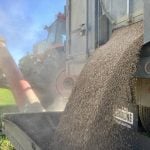Protecting any crop from plant diseases that lurk in the soil or in the stubble is a never ending battle for farmers and researchers. Often, however, it’s even worse in canola, as becomes clear with a quick look at clubroot and blackleg. Both attack canola and while scientists and farmers are doing their best to protect the crop, each disease provides unique challenges.
Clubroot is particularly tenacious. According to Holly Derksen, plant pathologist with Manitoba Agriculture Food and Rural Development (MAFRD), clubroot spores can survive as long as 20 years in the soil, although the half-life of a clubroot spore is considered to be just four years.
What’s more, she adds, these long-lived spores have the ability to swim in the soil and seek out plant roots. If they find young, weak plants or older, vulnerable plants, it can essentially be game over.
Sometimes it’s a matter of numbers. The more pathogens present in the soil, the more likely it is a crop will succumb to them, leaving farmers with a large bill for seed, planting, spraying and harvesting — but little to show for it.
Derksen explains how the clubroot pathogen multiplies. When the clubs that form on the roots of the canola plants mature, they’ll send more spores back into the soil. Those spores will wait patiently for the next canola crop to be planted before they attack again. The pathogen also mutates and adapts to new varieties of plants and fungicides used by the farmer. So, by the time a biennial crop rotation has hit its sixth year, or third rotation, seed varieties that were once resistant to a clubroot pathotype are no longer as effective. The next crop may not be a complete failure but the yield will drop.
Derksen cautions farmers against relying solely on a switch of seed varieties to keep clubroot under control, as even intensive research undertaken by universities, plant breeders and large companies can’t solve all the problems. She says when everyone concentrates on finding a gene that provides resistance to a new race or pathotype of a plant disease, it’s quite likely they’ve all found the same source. This means that even though a grower is planting a different seed variety with each rotation, there’s no guarantee disease resistance will remain high, because all the varieties have the same resistance gene and they’ll all succumb, to some degree, to a new pathotype.
Dr. Dilantha Fernando, professor of plant pathology at the University of Manitoba, emphasizes it’s important to maintain research efforts for resistance in the fight against clubroot and other soil pathogens. He says that, although Manitoba doesn’t have a lot of clubroot now, the disease can continue to spread because the spores don’t travel on their own but they can be carried from field to field on wind-borne soil particles or on equipment. Fernando notes that good biosecurity for farm equipment may not be enough to halt the spread of these microscopic terrors. But, he adds, “It’s especially important if you don’t have clubroot yet, and this is the situation in most of Manitoba.”
Fernando sees the longevity of clubroot spores as an ongoing challenge for farmers. He says, “A rotation itself in the normal way that we talk about crop rotation, a two- to three-year rotation, will not particularly take care of it… That’s why resistance is still the major and best method of success in controlling these pathogens.”
Read Also

Sensing the soil: Root cell research finds ‘stress hormone’
Research into how root cells react to soil stressors could help plants better adapt to changes in their climate.
Fernando says he thinks Canadian researchers have done an excellent job finding resistance to new races fairly quickly. But, he adds, “Sometimes the pathogen is smart and one step ahead of us.”
And sometimes researchers have to look to the past for results.
Fernando explains it this way. The resistant gene may already exist in the germ plasm in older varieties. Researchers can screen the varieties they’ve developed to see if a gene is already available. Then they can move very quickly to produce a new variety. But, if they have to find a new gene that has a natural resistance to a new pathotype that is attacking all existing varieties, it will take much longer, especially if it’s lodged in varieties bred in another country. That gene will have to be accessed and then crossbred into existing varieties and elite germ plasm.
Although conventional breeding takes much longer than identifying a resistance within known Canadian varieties, researchers do have the tools to combat new clubroot and blackleg pathotypes. Armed with new molecular techniques, worldwide collaboration between private companies and universities, financing from the agriculture industry, private enterprise and governments, a little luck and a lot of hard work they’re able produce positive results in the race to produce disease-resistant crops.
Fernando says the next clubroot challenge is a pathotype identified in Alberta and labelled 5x.
Blackleg has also been undergoing some changes too, Fermando says. “Blackleg has been controlled by good genetics for a long time, but that’s changing, due to new races of the pathogen.”
In the meantime, Fernando says, rotation and seed inoculants are the best line of defense against blackleg. He predicts that in the future seed suppliers will have to be able to advise farmers about which seed variety is resistant to the race of blackleg or clubroot pathogens in their fields.
Fernando says good farming practices are important in the fight against soil and stubble-borne pathogens. Strict biosecurity on and between farms will slow the spread of crop disease. High-quality seed will produce strong plants that are less likely to succumb to disease. Good rotation practices and attention to soil health will also help.
”Farmers play a major role in their own fields,” Fernando says.

















